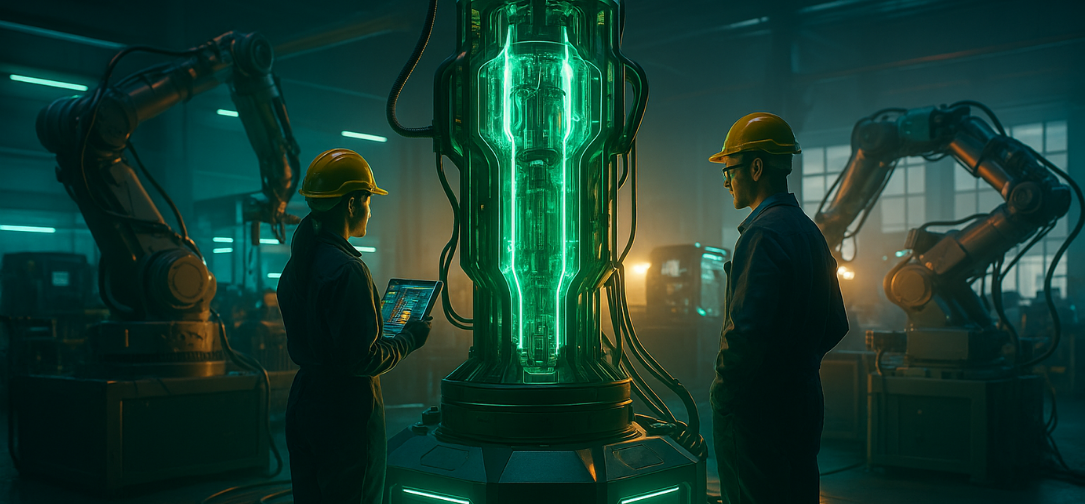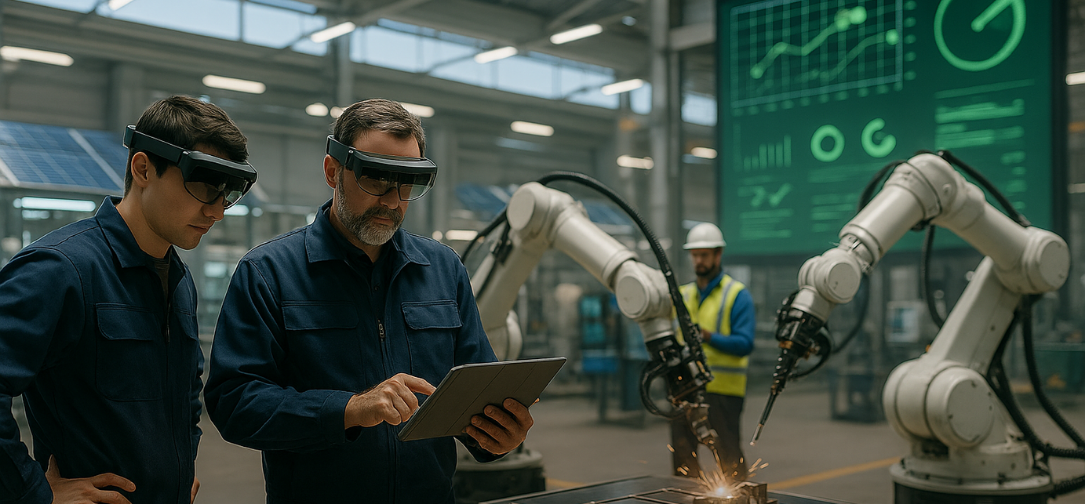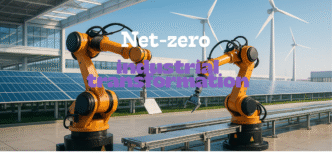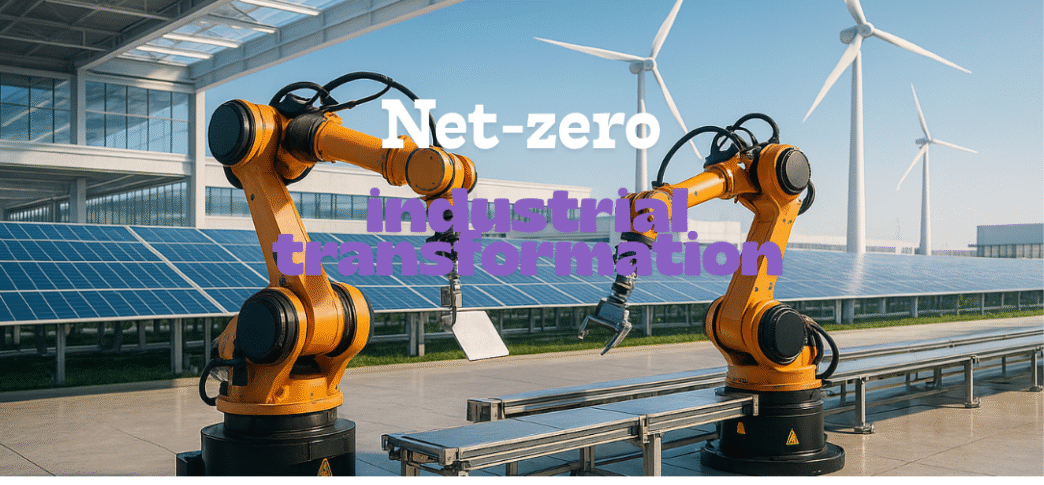In a world facing escalating climate pressures, green manufacturing has become more than a buzzword; it’s a necessity. As industries seek to reduce carbon emissions and achieve net-zero operations, technological innovation is reshaping how factories produce goods, manage waste, and optimise resources. From AI-driven efficiency systems to renewable-powered smart factories, the race to build the carbon-free factory is redefining the future of global manufacturing.
According to the International Energy Agency (IEA), manufacturing accounts for nearly 30% of global CO₂ emissions, with sectors like cement, steel, and chemicals contributing the most. As governments and corporations commit to net-zero targets by 2050, new technologies are emerging to tackle emissions across the entire production life cycle, from design and materials to logistics and recycling.
Technological Breakthroughs Driving the Green Factory Revolution
1. AI, Automation, and Digital Twins: Precision for Sustainability
Artificial Intelligence (AI) and automation are revolutionising how factories monitor, predict, and reduce their environmental footprint. Smart sensors, machine learning algorithms, and digital twin technology allow manufacturers to simulate and optimise processes before physical production begins.
A digital twin, a virtual replica of a physical system, enables predictive maintenance and energy optimisation. For instance, Siemens’ “Digital Industries Factory” in Germany uses digital twins to reduce downtime and energy waste, improving efficiency by up to 20%. Similarly, General Electric (GE) has implemented AI-powered analytics to cut energy consumption in turbine manufacturing, saving millions of kilowatt-hours annually.
By integrating IoT and real-time data analytics, manufacturers can detect inefficiencies, adjust energy use dynamically, and automate decisions that once required manual oversight. The result: fewer emissions, higher productivity, and lower costs.

2. Renewable Energy and Electrification of Industrial Processes
The move toward renewable energy sources is transforming the industrial power landscape. Factories are increasingly powered by solar, wind, and hydrogen-based systems, replacing fossil fuels that have long dominated industrial energy use.
Companies like Tesla, Apple, and Unilever are leading the charge. Tesla’s Gigafactories in Nevada and Berlin, for example, operate with 100% renewable energy, integrating rooftop solar arrays and on-site battery storage to maintain continuous, low-emission operations. Meanwhile, Unilever’s European manufacturing facilities are fully powered by renewable electricity, cutting CO₂ emissions by more than 50% since 2015.
A particularly promising development is the rise of green hydrogen hydrogen produced using renewable energy. Industrial giants such as ArcelorMittal and Thyssenkrupp are deploying hydrogen furnaces to replace coal-based smelting processes in steel production. This shift could reduce steel-related emissions by up to 95%, according to the World Steel Association.
3. Circular Manufacturing and Closed-Loop Systems
Circular economy principles are becoming integral to green manufacturing. Instead of the traditional “take-make-dispose” model, companies are designing closed-loop systems that reuse, recycle, and repurpose materials.
One standout example is Patagonia, which reuses production waste and recycled textiles to manufacture new products. In the automotive industry, Volvo and BMW have committed to closed-loop battery recycling, ensuring that critical minerals like lithium and cobalt are recovered and reused.
HP Inc. has also adopted circular manufacturing by reusing over 875 million plastic bottles in producing printer cartridges and hardware components. These practices not only reduce raw material dependency but also build resilience against supply chain volatility a growing concern in global manufacturing.
4. 3D Printing and Additive Manufacturing: Reducing Waste at the Source
Additive manufacturing (3D printing) is redefining material efficiency. Traditional manufacturing methods often waste up to 30% of materials, while 3D printing uses only what’s necessary to build a component layer by layer.
According to McKinsey & Company, 3D printing can reduce material waste by up to 90% in industries such as aerospace and healthcare. Airbus uses 3D-printed titanium parts to produce lighter aircraft components, resulting in reduced fuel consumption and emissions. Similarly, Nike has adopted additive manufacturing to create shoes with minimal waste and optimized performance.
Beyond reducing waste, 3D printing enables localized production, shortening supply chains and minimizing transportation emissions. This decentralization trend is key to the future of sustainable manufacturing.
5. Carbon Capture, Utilization, and Storage (CCUS)
For industries where emissions are hard to eliminate such as cement and chemicals carbon capture technologies offer a bridge toward carbon neutrality. CCUS captures CO₂ from industrial processes and either stores it underground or reuses it in other applications.
Climeworks, a Swiss startup, and CarbonCure Technologies in Canada are leaders in this field. CarbonCure injects captured CO₂ into concrete during production, reducing emissions while strengthening the final product. Meanwhile, Climeworks’ Orca plant in Iceland uses renewable energy to capture 4,000 tons of CO₂ annually from the atmosphere.
Industries Leading the Carbon-Free Transformation
Automotive: Electrification and Sustainable Supply Chains
The global auto industry is undergoing a seismic shift toward carbon-free manufacturing. BMW’s Plant Leipzig operates on wind energy, while Ford has pledged to make all European factories carbon-neutral by 2035. The integration of EV production, battery recycling, and green logistics is redefining how vehicles are made and how they are valued by sustainability-conscious consumers.
Steel and Cement: Heavy Industry Reinvented
Steel and cement, among the most carbon-intensive sectors, are adopting cleaner technologies. Sweden’s HYBRIT project, a collaboration between SSAB, LKAB, and Vattenfall, produced the world’s first fossil-free steel using hydrogen. Meanwhile, LafargeHolcim is piloting low-carbon cement that replaces clinker with recycled materials.
These innovations could reduce global industrial emissions by up to 20% if scaled worldwide, according to IEA research.
Consumer Goods and Electronics
Brands like Apple and Samsung are embedding green manufacturing into their product design. Apple’s 2030 Carbon Neutral Plan includes using recycled aluminum in MacBooks and investing in supplier clean energy programs. Samsung’s “Galaxy for the Planet” initiative aims to eliminate all plastics in packaging by 2027.

Economic, Ethical, and Policy Implications
Economic Upside: Green Equals Growth
Green manufacturing isn’t just an environmental imperative, it’s a trillion-dollar opportunity. The World Economic Forum (WEF) projects that sustainable manufacturing could unlock $4.5 trillion in new economic value by 2030. Investment in clean technologies has already reached record highs, with $1.8 trillion flowing into renewable energy and green infrastructure in 2024.
Moreover, job creation in sustainable manufacturing is outpacing traditional sectors. The U.S. Department of Energy estimates that green manufacturing could create 10 million new jobs by 2035 through retrofitting plants, renewable installation, and digital transformation.
Ethical Manufacturing and Supply Chain Transparency
Consumers are increasingly demanding transparency. Blockchain technology is now being used to verify supply chain sustainability. IBM’s Blockchain Transparent Supply initiative, for instance, helps manufacturers track materials’ carbon footprints from extraction to final delivery.
Ethical production is becoming a differentiator not just a compliance measure. Companies adopting ESG (Environmental, Social, Governance) frameworks are now seeing better market performance and brand loyalty.
Policy and Regulation: Governments Driving Change
From the EU Green Deal to the U.S. Inflation Reduction Act, governments are pushing industries toward cleaner operations. The EU’s Carbon Border Adjustment Mechanism (CBAM), for example, taxes imports based on their carbon footprint, encouraging global manufacturers to decarbonize or risk losing competitiveness.
In Asia, China’s 14th Five-Year Plan includes aggressive targets for clean energy integration in manufacturing, while Kenya’s Green Industrialization Strategy is positioning Africa as an emerging hub for sustainable production.
The Global Outlook: A Race Toward Net-Zero Factories
The march toward carbon-free manufacturing is accelerating worldwide. By 2030, experts predict that over 50% of new factories will be designed as net-zero or low-emission facilities, built with sustainability-first architectures. Emerging technologies such as AI-driven material science, biomanufacturing, and smart energy grids will make factories not only cleaner but smarter and more adaptive.
The transition will not be uniform. Europe is leading with strict emissions standards and public funding, the U.S. is leveraging private innovation, Asia is scaling through industrial policy, and Africa is leapfrogging with renewable-first approaches.
But one thing is clear the carbon-free factory is no longer a vision of the future. It’s a defining reality of the 21st-century industrial revolution.
Conclusion: The Future Is Clean, Circular, and Intelligent
Green manufacturing is transforming global industry from the ground up. As companies adopt cleaner technologies and data-driven processes, the factory of the future will be carbon-free, circular, and digitally intelligent designed not only for profit but for planetary survival.
The industries that embrace this transformation today will be the ones that thrive in tomorrow’s sustainable economy.














